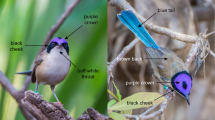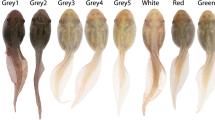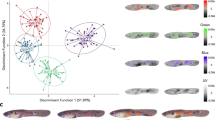Summary
The pupal colour dimorphism of Eurytides marcellus is nearly lost when the species is forced to pupate on a clear plastic substrate. Selection for extreme brown and green pupal colour under these circumstances was successful in a single generation in 3 out of 5 and 7 out of 10 lines respectively, but selection for an intermediate colour gave no response in 3 out of 3 lines. The results support a threshold model of pupal colour dimorphism in this species, with “sensitivity” to substrate characteristics being the underlying continuous variable. The consequently strong environmental component of variation in pupal colour in natural populations thus serves to maintain the genetic variation, since natural selection will be only weakly stabilizing.
Similar content being viewed by others
Article PDF
References
Clarke, C A, and Sheppard, P M. 1972. Genetic and environmental factors influencing pupal colour in the swallowtail butterflies Battus philenor and Papilio polytes. J Entomol, (A) 46, 123–136.
Falconer, D S. 1960. Introduction to quantitative genetics. Edinburgh and London, Oliver and Boyd.
Hazel, W N. 1977. The genetic basis of pupal colour dimorphism and its maintenance by natural selection in Papilio polyxenes (Papilionidae: Lepidoptera). Heredity, 38, 227–236.
Hazel, W N, and West, D A. 1979. Environmental control of pupal colour in swallowtail butterflies (Lepidoptera: Papilioninae): Battus philenor (L.) and Papilio polyxenes Fabr. Ecological Entomology, 4, 393–400.
Hazel, W N. 1980. The evolution and ecological genetics of pupal color dimorphism in swallowtail butterflies (Lepidoptera: Papilioninae). Ph.D. Thesis, Virginia Polytechnic Institute and State University, Blacksburg.
Merrifield, F, and Poulton, E B. 1899. The colour-relation between the pupae of Papilio machaon, Pieris napi and many other species, and the surroundings of the larvae, etc. Transactions of the Entomology Society of London, 1899, 369–433.
Sheppard, P M. 1958. Natural Selection and Heredity. London, Hutchinson.
Smith, A G. 1978. Environmental factors influencing pupal colour determination in Lepidoptera. I. Experiments with Papilio polytes, Papilio demoleus and Papilio polyxenes. Proc R Soc Lond, B, 200, 295–329.
West, D A, and Hazel, W N. 1979. Natural pupation sites of swallowtail butterflies (Lepidoptera: Papilioninae): Papilio polyxenes Fabr., P. glaucus L. and Battus philenor (L.). Ecological Entomology, 4, 387–392.
West, D A, and Hazel, W N. 1982. An experimental test of natural selection for pupation site in swallowtail butterflies. Evolution, 36, 152–159.
Wiklund, C. 1975. Pupal colour polymorphism and the survival in the field of cryptic versus non-cryptic pupae in Papilio machaon L. Trans R Ent Soc Lond, 127, 73–84.
Author information
Authors and Affiliations
Rights and permissions
About this article
Cite this article
Hazel, W., West, D. Pupal colour dimorphism in swallowtail butterflies as a threshold trait: Selection in Eurytides marcellus (Cramer). Heredity 49, 295–301 (1982). https://doi.org/10.1038/hdy.1982.103
Received:
Issue date:
DOI: https://doi.org/10.1038/hdy.1982.103
This article is cited by
-
Pupal Melanization in Heliconius erato phyllis (Lepidoptera; Nymphalidae): Genetic and Environmental Effects
Genetica (2006)
-
Expression of a dispersal trait in a guild of mites colonizing transient habitats
Evolutionary Ecology (1995)
-
Genetic variability and phenotypic plasticity in pupal colour and its adaptive significance in the swallowtail butterfly Papilio polyxenes
Heredity (1987)



